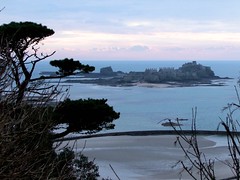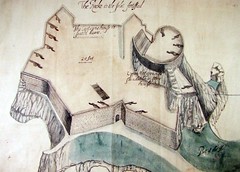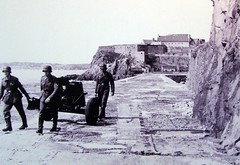- JERSEY
- GUERNSEY
- ALDERNEY
Elizabeth Castle
Elizabeth Castle was built in the 16th century when the power of cannons meant that the existing castle at Mont Orgueil was now unable to defend the Island and the busy port of St. Helier was vulnerable to attack by ships armed with cannon.
There was a tidal island called L’Islet in St. Aubin’s Bay which had become the site of the Abbey (later Priory) of Saint Helier. These monastic buildings were taken over by the Crown at the Reformation and the same buildings were then used for military purposes.
Construction of a castle began in 1594 and continued under the governor of Jersey, Sir Walter Raleigh, who named it “Fort Isabella Bellissima” (the most beautiful Elizabeth) after Queen Elizabeth the First. Jersey moved the official residence of the governor from Mont Orgueil to Elizabeth Castle.
Elizabeth Castle was first used as a military base during the English Civil War in the 17th century. Charles II visited the castle in 1646 and 1649, staying in the Governor’s House, and was proclaimed King by Governor Sir George Carteret despite the fact the monarchy had been abolished.
In 1651, Parliamentary forces landed in Jersey and bombarded the castle with mortars destroying the mediaeval Abbey church in the centre of the castle complex which had been used as the storehouse for ammunition. Jersey was held by Parliamentarians for nine years.
[flickr]tag:elizabeth+castle@Jerzzy Journey Boutique(,21)[/flickr]
The current parade ground and surrounding buildings were constructed on the site of the destroyed Abbey church.
The castle was next involved in conflict in the late 18th century, this time it was with the French. French troops under Baron Phillipe de Rullecourt who landed in St Helier on 6 January 1781, and the castle garrison was marooned.
The governor Moise Corbet was tricked into surrendering to the French, but the castle garrison under Captain Mulcaster refused to surrender. The French were eventually defeated by troops under Major Francis Peirson at the Battle of Jersey. Both Peirson and de Rullecourt were killed during the battle.
Increasingly powerful canon eventually meant Elizabeth Castle was vulnerable and led to the construction of Fort Regent on Le Mont de la Ville, purchased by the British government from the Vingtaine de la Ville overlooking the Town. Fort Regent became the site of the main British garrison.
There is breakwater linking L’Islet to the Hermitage Rock on which the Hermitage of Saint Helier is built which is used for fishing.
The British government withdrew the garrison and relinquished the castle to the States of Jersey in 1923.
[flickr]tag:elizabeth+bunker@Jerzzy Journey Boutique(,15)[/flickr]
During the Second World War the Germans, who occupied the Channel Islands, modernised the castle with guns, bunkers and battlements. After the Liberation of Jersey, the castle was repaired and was eventually re-opened to the public.
Every Sunday through the season when the castle is open, a team of Historical Interpreters recreate the garrison of 1781, at the time of the battle of Jersey. Displays are given of musket firing, cannon firing and civilian life.
Access to the castle is via a causeway from St Helier at low tide, or on a wading vehicle which can reach the castle regardless of tide state, weather permitting.




